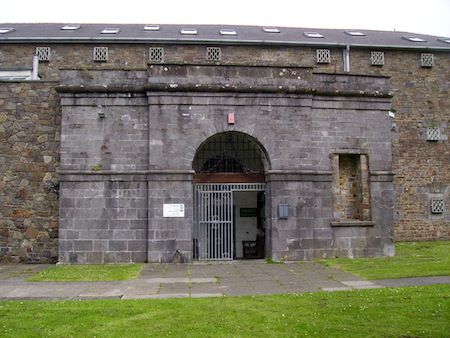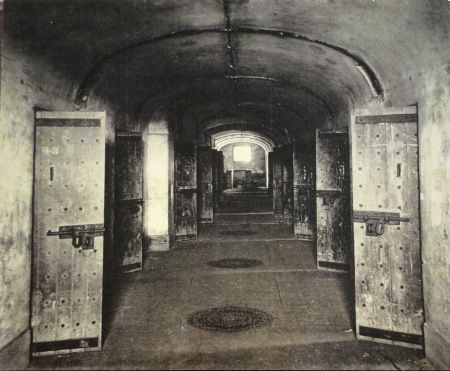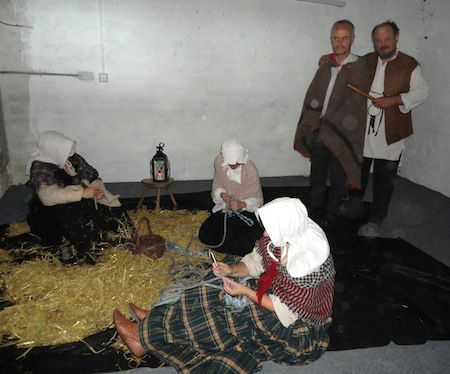Prisons in 19th century Pembrokeshire
16th January 2015
Every September, across Europe, Civic Societies are encouraged to try to make buildings available to the public that might not otherwise be accessible.
Haverfordwest Civic Society has a good record on this and on the 13th of September, last year, Pembrokeshire County Council gave permission for the old gaol at Haverfordwest Castle to be used.
A prison, or ‘House of Correction’, had been created during the 1770s within the inner ward of Haverfordwest castle but it was an extremely ramshackle, grim affair consisting of a double decker, timber arrangement against the north eastern wall.

Front of prison
Prison reformers, most notably John Howard, Elizabeth Fry and much later Charles Dickens campaigned endlessly for improvement in the treatment of prisoners but it was slow coming. As the result of an outbreak of scarlet fever, which the whole prisoner population succumbed to, a decision was made to build a new prison. With grant money of £1500 from the government in 1817, the prison was built that we are all familiar with.
This prison, for the county, was in addition to the tiny town gaol that stood originally in the Mariner’s Square before being moved a few yards to a point immediately below St Mary’s Church wall in St Mary’s Street.
A huge treadmill was erected in 1820 at a cost of £473 to provide the element of hard labour. The wheel was built by and was the invention of Sir William Cubitt whose engineering talents led to him being used internationally and he introduced a water supply to Berlin and surveyed the Paris to Lyon railway.
Two teams, each of eight to ten prisoners were used on the wheel, each team doing ten minutes whilst the other rested. A normal day would require ten hours of this. Although the object was largely to create ‘hard labour’ the wheel turned a millstone which ground the corn for the prison bread. A miller was employed by the prison to supervise the wheel operation.
Female prisoners were expected to do turns on the wheel but as elsewhere in the prison there had to be a partition placed between them and any males on the same wheel shift. Women were also used for the domestic needs of the prison such as in the laundry and kitchen, whilst men were required to break stones used for road building or repairs.
Those deemed unfit for health reasons for any of these tasks were required to ‘pick oakum’ which was perhaps the most hated of all jobs in that rope that was considered too valuable to throw away, but was worn and covered in tar, had to be unpicked to enable the threads to be used again. All that is being described here is not dissimilar to the life of those in the Workhouse whose inmates were equally considered criminals, in this case for being poor.

These are the cells of the former prison at the castle.
These no longer exist.
Image courtesy of Haverfordwest Museum
The building ceased to be a gaol in October 1878 and became the headquarters of Pembrokeshire County Police which it housed for almost 100 years.
The interior of the building was radically altered in the 1960s to house the Record Office and an upper floor was created and used for the museum. The Town Museum has since moved into the Governor’s House and the Record Office/Archives moved into its Prendergast home on the 23rd March 2013.
Just as recently have been the attempts of a developer to purchase the building and turn it into a ‘bijou’ hotel. An application by Haverfordwest Town Council, based on an idea submitted by Haverfordwest Civic Society, to have the Castle and its grounds registered as a Village Green (which would have protected it from any development) was defeated following a public hearing held in County Hall in the autumn of 2013.
This is a building which, sadly, you probably won’t have an opportunity to view in the future.
Thanks to the knowledgeable staff of the the Town Museum, from whom much of the research for this article has been obtained.
Haverfordwest Civic Society European Heritage Day 13.9.15

Female prisoners in the gaol being watched by the gaoler as they undertake the job of ‘picking oakum.
European Heritage Day reenactment.
European Heritage Day conducted by Haverfordwest Civic Society in the Old Prison at Haverfordwest Castle on Sunday proved a tremendous success. Over the course of the day over 400 people were given a brief talk on the history of the building and a guided tour. Tea and cake was dispensed on an epic scale thanks to the baking skills of ladies attached to either the Civic Society or Town Museum. Donations received by the Society were handed to the Town Museum who had an equally successful day. In total £800 was raised to help the museum.